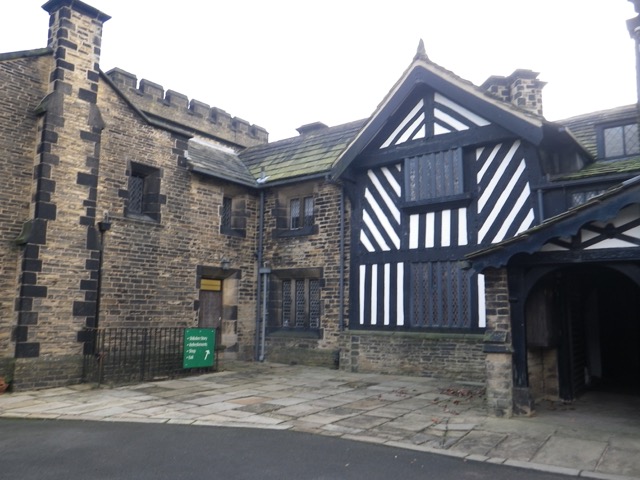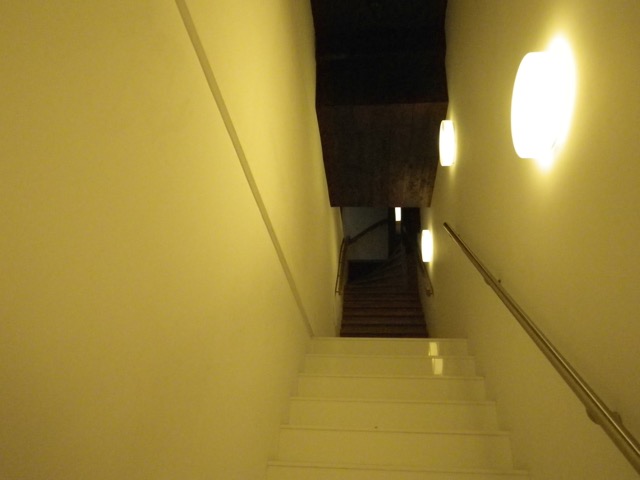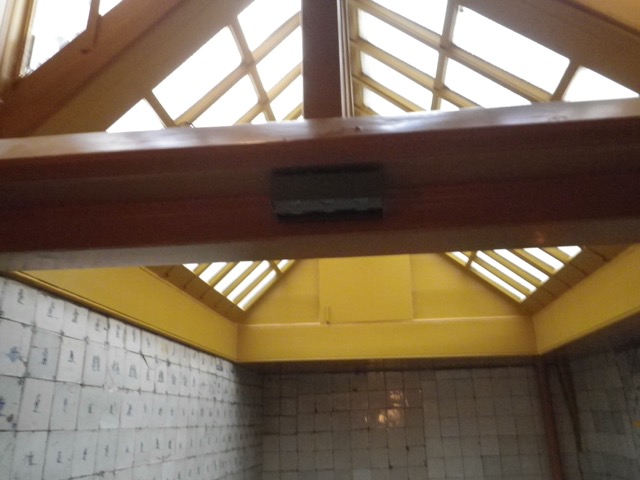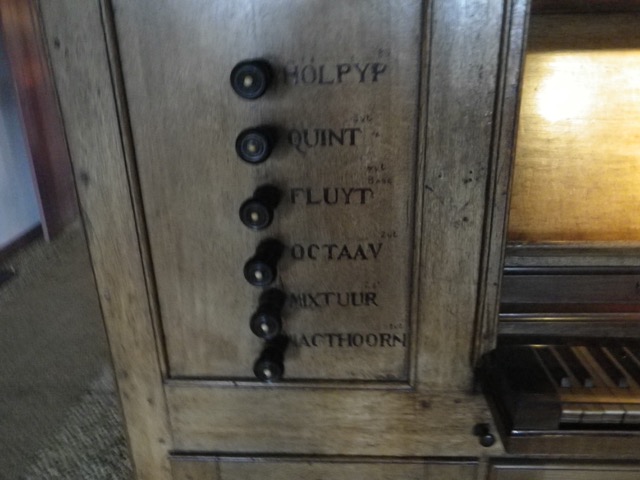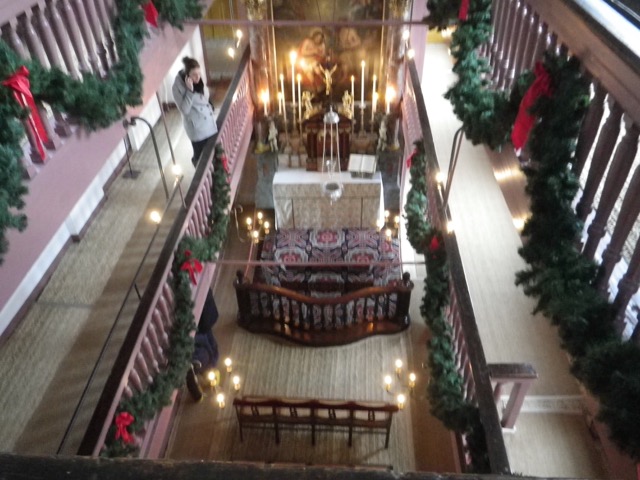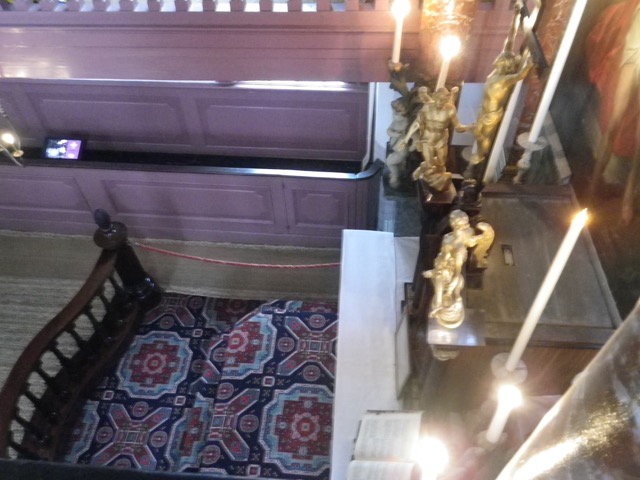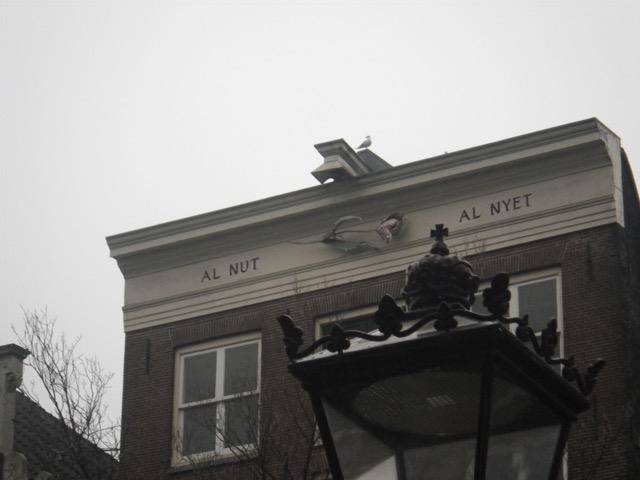Here are a couple of random bonus Amsterdam pics I forgot I took for my last Amsterdam post…
These cute cars are all over the city.

They can only go very slowly. I think they sound like a greater alternative to a scooter.

A sign outside Salsa Shop:

And part of Salsa Shop’s wall of deliciousness. There were probably 10 times as many bottles in the shop.

Okay, so on to Manchester.
The bed here is terrible so I’m shocked that I slept a solid six hours to 5AM. I then tried to go back to sleep for a few hours, but kept getting woken up by the other people in the building talking loudly as they went about their morning routine. Nothing I can fault anyone on; it’s what I expected. I was offered an air mattress to sleep on instead and I will try that tonight. I don’t have to be up tomorrow, so if should be able to get a little caught up on my sleep. I did have to be up today since I had booked a walking tour for 11.
So I got up around 8:30 and took my time with breakfast and coffee. That was pleasant, I have to say, and I’m glad I didn’t rush out the door. I was also glad that it wasn’t freezing in here at all, which I’d expected based on reviews. I did use two duvets, but slept under them in just a tee shirt and was comfortable. So, really, in the light of having had some sleep my dump was much homier than expected and I continue to have no regrets for having picked it.
Besides the price, the reason I picked this less than one-star accommodation was the proximity to public transport and ease of getting into Manchester. It was a straight shot on the train and short walk from the airport and a bus into Manchester can be taken about three blocks away. With the buses running every few minutes and the 5KM ride estimated to take 20 to 30 minutes, I left around 9:45. I had done my research ahead of time and learned that instead of buying a single fare for £2.90, I should buy a day pass for £4. In other cities I’ve visited, buying such a pass requires making at least three trips to be worth the purchase, but for Manchester, it’s a good deal on just a return trip!
Conveniently, the final stop on my route was about two blocks from where the Free Manchester Walking Tour started, at Sackville Gardens by the Alan Turing statue.
Manchester didn’t make much of an impression after I got off the bus, despite being full of these wonderful red brick buildings that I would learn were once warehouses for textiles.

I found Alan Turing‘s statue without any problems. If you do not know who Alan is, I am very sad. Please stop reading this blog and go watch the recent film The Imitation Game. It’s okay. I’ll wait. Can’t be bothered? 🙁 He was a brilliant mathematician who is pretty much the father of modern computing. He helped crack the Nazi Enigma code, which surely brought about an earlier end to WWII, saving thousands of lives. He was also gay at a time when being gay in the UK was illegal, was chemically castrated for his crime, and died young, presumably from suicide. He was a great man who deserved so much better. I wasn’t crazy about The Imitation Game (was a bit too familiar with the story to be wholly satisfied), but it revived interest in Alan and his work.

Why is Alan wearing a scarf? It’s a homeless initiative. Have an extra scarf? Drape it around Alan. Need a scarf? Alan should have one for you.
By the way, that statue is a disgrace and looks nothing like him!

These mosaics bring attention to import LGBT sites around Manchester.

I was super early early, so I found a café with Barcelona coffee prices (that’s a good thing after Amsterdam) and had a macchiato with cinnamon. Mmm.
When I got back to Alan’s statue, a crowd had start to gather and our host, Josh, soon showed up. Introductions were made and the tour started around 11:10. I’m just going to say here that Josh’s tour is one of the best I’ve been on and he was very interesting and funny, but my brain is so fried that I can barely remember anything he told us. 🙁
He started with a brief history of Manchester, separated into four epochs, from the Romans in AD 79, through the Middle Ages, during the Industrial Revolution, and then modern Manchester. His tour focuses on the latter two periods of Manchester’s history, but the intro helped to set the city into its historical context. I remember that “chester” means that there was a Roman fort in the environs and that the original name of the city was the Latin equivalent of the name of a mountain range in Wyoming for the exact same reason: Mamcium — Teton — breasts-shaped mountains.
He also told us a bunch of grandiose quotes about Manchester that betrayed how full of itself the city can be. There is quite a rivalry with Liverpool and to a lesser extent London. Much later in the tour, I asked if it’s true that Manchester is becoming a more affordable answer to London and Josh said that’s right and that one of the results is that he’s been priced out of downtown. He’s quite concerned about a new train link that will put London an hour away as that’s commuting distance.
One of our first stops was UMIST, University of Manchester Institute of Science and Technology. I wish I could remember more than that because I know there was more, but my brain really is mush tonight.


We then learned a bit about Alan and the legend that the Apple logo originated with him (not true). There was also a plaque in the area saying that we were standing by an apple tree grown from a seed from one of Sir Isaac Newton’s apples, but there was not an apple tree to be seen.
Next, we went to the monument to Vimto, a drink I’d never heard of that was invented by a Quaker (I think) as an alternative to alcohol. It is apparently hugely popular in the Arab world.

Josh gave us a sample of the fizzy version of the drink, which was apparently a travesty. It smelled and tasted like cough syrup. Some Mancunians (residents of Manchester) on the tour said that the non-fizzy drink is nice diluted with hot water, but I don’t think it’d be to my taste.

We moved on to Orient house, which is the building with the scaffolding.
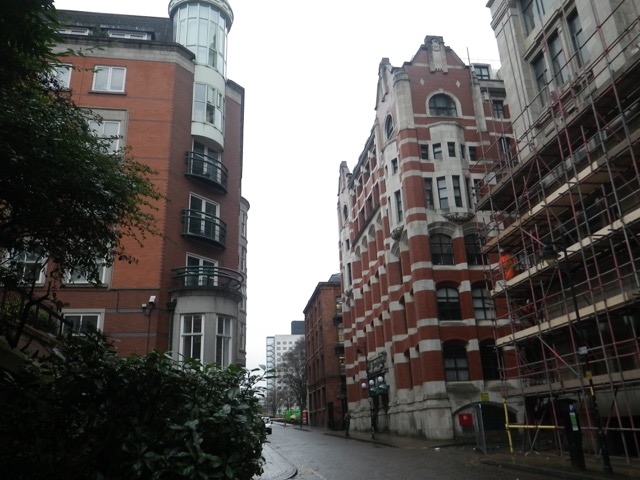
Josh told us how his friend Ben lived in this building in quite a grotty apartment that was very Manchester with its view to train arches and other things, but Ben was evicted with four weeks’ notice so that the building could be renovated and turned into luxury housing. I asked if Ben is homeless now. Nope. The story has a happy ending. Ben is living in a lovely new place that’s a bit more expensive. Why am I telling you this? Josh said Ben would get a kick out of seeing his story in my blog. 🙂

We moved on to the shores of the mighty Medlock River…

This is right by the building where Noel Gallagher of Oasis wrote the songs for “Definitely, Maybe.” Oh, that reminds me of something!
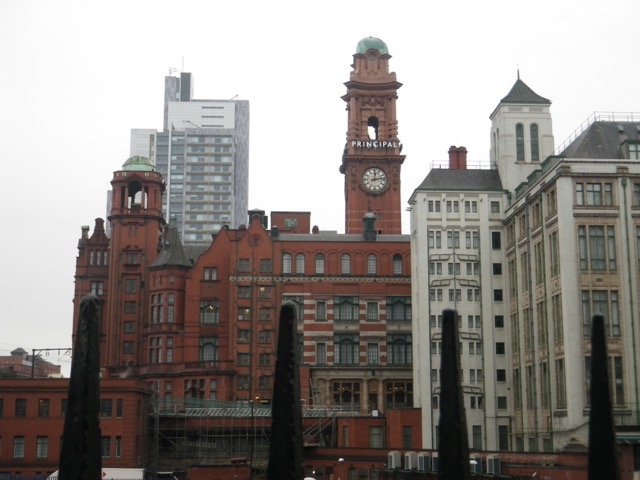


So Manchester was the first industrialised city in possibly the whole world, or at least in the UK. Its industry was textiles, primarily cotton. But the city went into decline in the early 20th century and industry pretty much ended after the 1940 Blitz. The city rather reinvented itself as an alternative music scene and was the home of that techno punk type music, with lots of raves and a club scene. Totally not my thing, but it was interesting to see the contrast of this very classical looking city with its rather liberal attitudes. There’s quite a large gay scene here as well.
We walked along a canal that reminded me of Amsterdam.


To the heart of Manchester’s gay village. Josh told us how gay men would hang out at the Union Hotel and there were frequent raids while prostitutes hung out a few blocks away and were also frequently raided. They finally had the bright idea to hang out together and pretend to be a legitimate hetero couple when the police came knocking. It worked. LOL! But the owner was finally told that he couldn’t keep running his business that way and that something had to change. So he appended the word “New” to his establishment…



Manchester’s animal is the worker bee, which symbolises all that Manchester wants to be.




I love the pub names and Josh found it funny that we North Americans are so enchanted by this.

I am really distressed by how little I’m remembering. Sorry for the worst travel post ever. Josh’s tour deserves better!

This was a neat building in that every floor is in a different architectural style.



We went into Chinatown. The ratio of Chinese to non-Chinese here is the highest in the UK.


This was a neat building. It leads down to… a nuclear bunker. It was built during the Cold War for a whopping £4 million to house only 40 people. It was a classified and very top secret building that, really, was useless. There are tunnels leading out of it and British Telecom ran phone lines through them. A homeless person caused a fire down there that not only took out phone service in the area, but also the internet in part of Sweden. Josh is not sure how that happened but swore it’s true!

The city library.

The Midland Hotel. Hitler loved it and wanted it for Nazi headquarters after Germany won the war.







We took a break here as we’d been going for two whole hours that would have flown by had it not been so bloody cold and wet out. We stopped for a hot drink at a Cafe Nerro where I also splurged on a giant oatmeal raisin biscuit since I hadn’t realised the tour was so long and wasn’t going to make it to lunch. This is where I discovered my useless phone had dropped from 70% battery life to 9% despite having no apps open and being on Airplane Mode. I’m going to miss Siri, but I’m going to a better phone next… I had a Lightning cable on me, but no way to plug the phone in. Josh saved the day by offering me a wall charger! We were in the café just long enough to get my phone up to 52%, which got me home.
We continued on to Manchester Central, which is a convention centre, not a train station, and the site of the Peterloo Massacre. Please go read up on it, but the short of it was that a bunch of unarmed protesters for the reform of parliamentary representation were slaughtered in 1819.


This Hilton hotel is the tallest building in the area and howls when the wind blows.

We moved on to the Free Trade Hall, site of an important moment in the history of the suffragettes. It’s the only hall named after an idea rather than a person. Manchester was a bit late in getting parliamentary representation, so it was poorly supervised and taxed, allowing free trade and commerce to flourish.


Next door is the Royale Theatre, the oldest in the city.


Now, Manchester City Hall, which rather looks like Canada’s Parliament Buildings.

This is Albert Square and that’s Albert’s monument. Albert as in the consort of Queen Victoria, who did not attend the opening of the building. Her statue is somewhere else in the city and she apparently looks like Jabba the Hutt… which reminds me that except for that statue, there are no statues of women in Manchester! Within a few years, there will be one of a suffragette, though.




I correctly guess that the decoration at the top of the tower is a cotton ball.

Next we moved to Lincoln Square. What a good likeness of Abraham Lincoln this is! This statue represents Manchester’s link with the US during the US Civil War. Manchester was a procurer of slave cotton, but ultimately put an embargo on it and instead moved to non-slave, inferior cotton from the Middle East. This contributed to speeding up the collapse of the Confederate economy. This is in no way to say that Manchester brought about the end of the Civil War, but its actions did speak loudly.

We then went into the wonderfully warm Royal Exchange, which is now a theatre and café.


This board is where the stock prices were advertised. The numbers shown are from the last day of trading, which I believe was 1969.

I forgot to ask how the numbers got changed considering how high up this thing is, but I now see the railing, so I imagine there’s a catwalk behind it.

Right in the middle of the space is a theatre in the round for 755 people, with none of the seats being more than eight feet from the stage.


We finished our tour here, where we learned about the June 15th, 1996 IRA bombing. I learned that authorities got about a 90-minute warning that the bomb was going to go off and they found it, but it could not be diffused in time so they decided to let it explode. They evacuated about 75,000 to 80,000 people, which is an amazing feat. There were injuries and heaps of property damage and economic consequences, but no one was killed. This would be a watershed moment for a city in decline as the rebuilding efforts brought a new vitality to the city.

This is the corn exchange building.

The bomb detonated just about here.

I remember that bombing so clearly. It was the month that I graduated from high school and just weeks ahead of my last trip to Quebec City.
Thus ends Josh’s tour. One last time, do not judge it based on this post. 🙂
It was probably the weather, but Manchester didn’t make a huge impression on me. Museums are free, but I’m really museumed out and glad I have an excuse to stay home tomorrow.
After the tour, I headed back towards the Royal Exchange as I’d spotted a Barclay’s, where I was able to take out some more cash. You may wonder why I didn’t simply make a larger withdrawal yesterday and the short answer is it’s what I had in that account and I had to move money around to get more. 🙂

By this point, I was very wet, very cold, very tired, and getting grumpy, so it was time to find food and get home. I was disgusted by how many streets downtown did not have signage so my map was all but useless, plus it was disintegrating in the damp.
My original plan for the day, when I thought the tour was two hours long, was to have a cream tea after and then get a takeaway later for dinner. But the tour had run way over and it was three by the time we were done (four hours!). So it was time for a proper meal. I decided to splurge and get a full tea even if I knew that would be around £20. I’d done my research for the cream tea and wanted to try the Richmond Tea Rooms, which were conveniently right by Sackville Gardens and on the way to my bus.
I passed this mural on the way, which had a much better likeness of Alan.

I found the Richmond Tea Rooms without any trouble. They have an Alice-in-Wonderland over the top theme. Very cute! As expected, a full tea was over £20, but they had a “Hatter’s” tea for just £10.50 with sandwiches, a scone, and a pot of tea! I knew that would be plenty.
Service was super slow and I rather regretted going when I was tired, grumpy, and starting to get a headache, but I’m glad I stuck it out. The server asked if I had any dietary restrictions and offered to sub tomato and cheese for egg salad when I told her. This is what they brought me:

I had three small sandwiches with a bruschetta-type thing and also an onion and bell pepper tart that I was told had no egg in it, just cheese. SO good! The sandwiches were chicken, ham and butter, and tomato and cheese. Dessert was a huge raisin scone with clotted cream and jam. For tea, I picked their house blend. This was definitely plenty. It’s now four hours later and I’m only just starting to get peckish.
The Richmond Tea Rooms really put on a nice tea. The food was at least as good as at the Wolseley in London, but, of course, I didn’t have the same level of service.
It was past four and pitch dark when I got out of there. I went back to the area where I got off my bus only to see one with my number at a bus stop on the correct side of the way to head home. I didn’t bother rushing to it since I knew another would come along quickly. Sure enough, by the time I’d made my way to the bus stop at a leisurely pace that respected the traffic signals, another one was pulling up. It was very full, so I went upstairs, my first time riding in the top level of a double decker since Edinburgh!
Unlike in most other cities with bus services, Manchester’s buses don’t announce the stops, so I had to keep an eye out to make sure I didn’t get taken for a ride. I ended up missing my stop, but the next one wasn’t much further and I would have ended up walking the same amount anyway. I popped into Tesco to get something light for dinner, settling on some Pot Noodles that would just need water from the kettle and a huge salad.
Weather aside, it was a good day in Manchester. I’m glad I picked the walking tour as my only activity here as it gave me a good idea of what the city is all about.











































